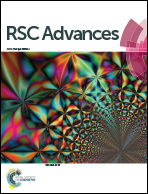A novel interfacial synthesis of MnO–NiO–reduced graphene oxide hybrid with enhanced pseudocapacitance performance†
Abstract
We demonstrate a facile one-step interface approach to in situ grow MnO–NiO nanoparticles on reduced graphene oxide via a DMF–water double solvent system without any addition agent. The dispersed MnO–NiO nanoparticles provide high theoretical capacitance. The uniform growth and attachment of MnO–NiO nanoparticles on the graphene nanosheets offer greatly decreased contact resistance and effective charge transfer. Simultaneously, graphene plays an architecture support role to ensure stable structure. Electrochemical measurement results show that the MNG electrodes deliver a high specific capacitance of 813 F g−1 at 0.5 A g−1, excellent rate capability (80.56% retention at 4 A g−1) and good cycling stability. In the one-step interface approach, the excellent dissolving capacity of DMF allows inorganic salts directly used as reagents in organic phase instead of conventional organic reagents, which fundamentally reduces the internal resistances of the electrode active materials. By virtue of this significant expansion of reagent categories and the convenient experimental accessibility, this improved interface method might be a promising approach to develop other classes of hybrids based on graphene for electrochemical energy storage devices and readily to scale up.


 Please wait while we load your content...
Please wait while we load your content...